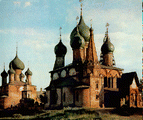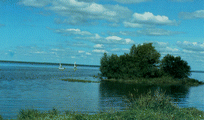[ SSD Home | Search SSD ]
Yaroslavl
![]()
 The
ancient Russian town of Yaroslavl stands on a high, steep bank of the Volga
river surrounded by boundless forests. In the beginning of the 11th century,
Prince Yaroslavl-the-Wise
The
ancient Russian town of Yaroslavl stands on a high, steep bank of the Volga
river surrounded by boundless forests. In the beginning of the 11th century,
Prince Yaroslavl-the-Wise ,
wishing to secure the borders of his principality, mounted a campaign against
the bellicose pagan tribe living in this part of the country. He subdued
them and killed the sacred bear, whom the heathens worshipped. To secure
his victory Prince Yaroslavl ordered the construction of a fort. That is
how, according to legend, the town of Yaroslavl originated. The town's
coat of arms depicts a bear holding a pole-axe. In the beginning of the
13th century, the town became the capital of the independent Rostov and
Suzdal principality, and soon after, like the other towns in Northeast
Russia, it was invaded by the Tatar and Mongol hordes.
,
wishing to secure the borders of his principality, mounted a campaign against
the bellicose pagan tribe living in this part of the country. He subdued
them and killed the sacred bear, whom the heathens worshipped. To secure
his victory Prince Yaroslavl ordered the construction of a fort. That is
how, according to legend, the town of Yaroslavl originated. The town's
coat of arms depicts a bear holding a pole-axe. In the beginning of the
13th century, the town became the capital of the independent Rostov and
Suzdal principality, and soon after, like the other towns in Northeast
Russia, it was invaded by the Tatar and Mongol hordes.
The first rise against the Golden Horde were the freedom-loving residents of Yaroslavl. In 1257, Prince Konstantin lead the Yaroslavl warriors against the invaders, but they all perished in the bloody and uneven struggle. Beyond the Kotorosl river in Yaroslavl stands the Tugov hill (hill of sorrow),to which people came to weep and pay homage to those who perished. The Tatar and Mongol yoke lasted over two centuries. In time, the devasted town Yaroslavl was re-built and in the 15th century it united with Moscow. By the 16th century Yaroslavl became one of the major trade centres of the Russian state. At that time the major trade routes from the west passed from the White Sea, the Northern Dvina and through the Volga to the East, Central Asia and down to India. This major trade route connected all of central Russia.
The Transfiguration monastery, the greatest architectural ensemble in Yaroslavl dates back to this period. It was a mighty fort on the Volga, as well as a cultural centre. At present it houses the historical museum with more than two hundred thousand exhibits-icons, ancient manuscripts, miniatures, books, archaeological and numuismatical finds, ancient household items, religious objects, clothing and wood carving.
 In
1610 when Moscow was captured by the Polish and Lithuanian invaders, Yaroslavl,
for a short time became the capital of the Russian state. Here in Yaroslavl
the national heroes Minin and Pozharsky gathered a force of over twenty
thousand that set out on a campaign to liberate Moscow.
In
1610 when Moscow was captured by the Polish and Lithuanian invaders, Yaroslavl,
for a short time became the capital of the Russian state. Here in Yaroslavl
the national heroes Minin and Pozharsky gathered a force of over twenty
thousand that set out on a campaign to liberate Moscow.
 In
the 17th century, Yaroslavl played an ever increasing role in the life
of the Russian state. In territory and number of residents it was second
only to Moscow. At this time the construction of stone buildings, primarily
churches began, and different handicrafts developed. Throughout the 17th
century the local stone-masons, artists, cualkers, iron smiths, carvers
and craftsmen working with gold and tiles developed the original Yaroslavl
branch of Russian folk crafts. With the construction of the St.Nicholas
Nadeina church (1620-1622) and the Native church (1635-1644) stone masonry
begins to flourish in Yaroslavl. The bold and novel architecture of these
churches was to the liking of the residents and the builders alike. And
architects began to discard strict symmetry in the favour of compositions
making free use of space.
In
the 17th century, Yaroslavl played an ever increasing role in the life
of the Russian state. In territory and number of residents it was second
only to Moscow. At this time the construction of stone buildings, primarily
churches began, and different handicrafts developed. Throughout the 17th
century the local stone-masons, artists, cualkers, iron smiths, carvers
and craftsmen working with gold and tiles developed the original Yaroslavl
branch of Russian folk crafts. With the construction of the St.Nicholas
Nadeina church (1620-1622) and the Native church (1635-1644) stone masonry
begins to flourish in Yaroslavl. The bold and novel architecture of these
churches was to the liking of the residents and the builders alike. And
architects began to discard strict symmetry in the favour of compositions
making free use of space.
The church of Ilya the Prophet (1647-1650), that stands in the centre of the town, is the pride of Yaroslavl. This five dome, four pillar church standing on a high base has a two-tier gallery with ornate porchers. The well-proportioned marquee annex is asymmetric to the elegant marquee belfry.
By freely varying architectural design and by richly decorating church buildings with coloured tiles the Yaroslavl craftsmen achieved buoyancy and beauty. A good example is the coloured church of Our Lady of Tykhvin (1686).And the Epiphany church (1684-1693) is brightly decorated with colour tiles.
 Every
district of the town, every street and every merchant vied with each other
in constructing churches. This gave great impetus for creativity and the
appearance of new talented craftsmen. Art and architecture in Yaroslavl
reached its apex in the second half of the 17th century. By this time all
the best edifices were built, determining the future appearance of the
town. One of the richest and most majestic of temples is the fifteen dome
church of St.John the Precursor in Tolchkov. It is constructed of musty-shaped
bricks and coloured tiles. Just as attractive is the ensemble in Korovniki-the
church of St.John Zlatoust (1649-1654),the church of Our Lady of Vladimir
(1699) and the Belfry (1680). From afar the ensemble is very attractive,
but in close proximity the church of St. John Zlatoust, one of the masterpieces
of Yaroslavl architecture, is especially engaging.
Every
district of the town, every street and every merchant vied with each other
in constructing churches. This gave great impetus for creativity and the
appearance of new talented craftsmen. Art and architecture in Yaroslavl
reached its apex in the second half of the 17th century. By this time all
the best edifices were built, determining the future appearance of the
town. One of the richest and most majestic of temples is the fifteen dome
church of St.John the Precursor in Tolchkov. It is constructed of musty-shaped
bricks and coloured tiles. Just as attractive is the ensemble in Korovniki-the
church of St.John Zlatoust (1649-1654),the church of Our Lady of Vladimir
(1699) and the Belfry (1680). From afar the ensemble is very attractive,
but in close proximity the church of St. John Zlatoust, one of the masterpieces
of Yaroslavl architecture, is especially engaging.
The churches of Yaroslavl are famous not only for their unique architecture,
but for their fresco-painting, as well. The churches, interiors are richly
decorated by frescos on mythological, historical and religious topics.
Many of these frescos, executed in the vivid artistic manner popular in
the 17th century Yaroslavl, have been restored and freed of later coats
of paint In the 18th century like other Russian towns, Yaroslavl became
to be built-up according to plan. The layout of the central district was
perfected, streets were straightened and widened and attractive houses
that are standing still, appeared. In the 19th century trade rows were
built and the embankment was remodelled. And in the beginning of this century
the building of the Volkov theatre was built. Near the juncture of the
Volga and Kotorosl rivers, the site where the city originated, there is
a park now. Here a monument, with an eternal flame, was constructed in
honour of labour and military deeds of the city's residents. The embankment
in Yaroslavl is one of the most attractive on the Volga. Here stand the
Palace of the Metropolian (17th century) and the Governor" s Palace. The latter houses the city's
art museum with a good collection of icons and works by the outstanding
Russian painters.
(17th century) and the Governor" s Palace. The latter houses the city's
art museum with a good collection of icons and works by the outstanding
Russian painters.
Yaroslavl is now one of the country's major industrial centres. The residents of the city are proud of their famous compatriots-the poet Nekrasov, the educator K.Ushinsky and the singer L.Sobinov. Valentina Nikolayeva-Tereshkova, the world's first woman cosmaunaut, is a native of the city.
The residents of Yaroslavl, while respecting the memory of their courageous and talented ancestors, are actively participating in the historic endeavours of the twentieth century.
![]()
More information on Yaroslavl:
![]()
Best viewed with Netscape Navigator. Last updated on January 30, 1997. Web design by Oleg Yu. Repin